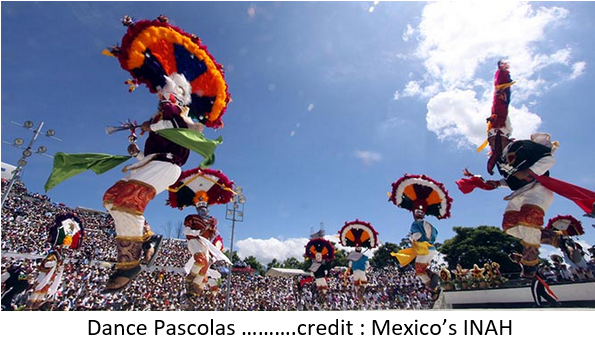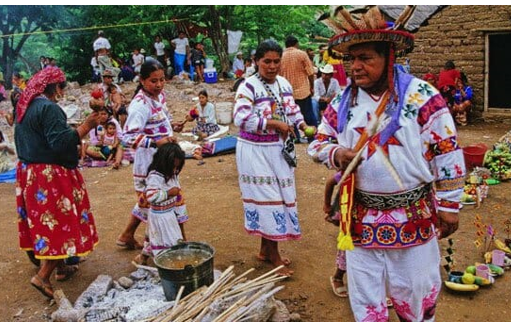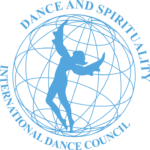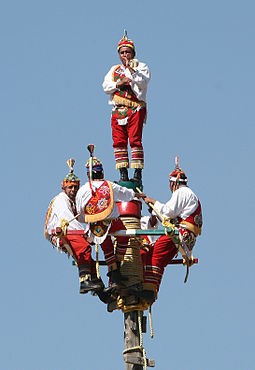Mexico
In Mexico we find plenty of sacred dances , draftly belonging in three groups :
– Authentic pre-hispanic dances
– Synchretic dances : mixture of christian and pre-hispanic
– Folklore Dances with pre-hispanic characteristics
Dr Patricia Elizabeth Torres Villanueva is Director of the Institute of Interdisciplinary Anthropological Investigation, A.C. Huei Tlahtolli in Mexico. Her research concerns ancestral Mexican and Mesoamerican ritual dances and she will contribute to a collection of them
In the meantime please have a look at
1 In the Online Seminar of June 3 2023 “TLALMANALI : Pre-Hispanic Sacred Dances”
2 In our Website ‘s Section Middle American Dances
List Of Dances
Danza de la Serpiente
Danza de aves
– Danza de los Moros y Cristianos
Pascolas

The triple teams of pascolas, or wooden-masked clown dancers descend from prehistoric clown-shamans.
The Dance of the Pascolas and the Deer is a ritual that has been practiced for over 300 years as a call for rain to the gods, and is studied by specialists from the National Institute of Anthropology and History (INAH), who are currently working on the creation of a file in order to include this practice on the Tentative List of Intangible Cultural Heritage, of the United Nations Educational, Scientific and Cultural Organization (UNESCO).
AUTHOR : Arizona State Museum
Reference : What is a Pascola? “Read”
MEXICO
Region: North
Ethnic group: Mayas
Peyote

Peyote (danced by Huichols)
The peyote (hikuli) dance, held in November, follows Huichol and Tarahumara pilgrimages . The dance of the Huichol is the more ecstatic. After consuming the trance-inducing peyote, men and women move in a counterclockwise progression, leaping jerkily and twisting their bodies.
One most important Huichol ceremony is the “Dance of the Deer.” People dance their prayers into the altar of Mother Earth and connect with the Deer Spirit, a very important Huichol animal power. The deer is seen as an elder brother, a guide, which the shamans use to navigate the spirit realm and also for healing. In the Huichol mythology, the gods and goddesses taught the deer in ancient times. It was the first student to learn the secrets of the original shaman, Grandfather Fire.
AUTHOR : Dance of the Deer Foundation
Reference : The mission of the Dance of the Deer Foundation Center for Shamanic Studies “Read”
MEXICO
Region: CenterWest
Ethnic group: Huichols
Voladores
Danza de los Voladores
The Dance of the Flyers is an ancient Mesoamerican ceremony/ritual still performed today, albeit in modified form, in isolated pockets in Mexico. It is believed to have originated with the peoples in central Mexico, and then spread throughout most of Mesoamerica. The ritual consists of dance and the climbing of a 30-meter pole from which four of the five participants then launch themselves tied with ropes to descend to the ground. The fifth remains on top of the pole, dancing and playing a flute and drum. According to one myth, the ritual was created to ask the gods to end a severe drought. The ceremony was named an Intangible cultural heritage by UNESCO.
AUTHOR : UNESCO
Reference : Unesco’s Website “Read”
MEXICO
MESOAMERICA
Region: Center
Ethnic group: Nahua, Huastec and Otomi
It is believed to have originated with the peoples in central Mexico, and then spread throughout most of Mesoamerica
GUADELUPE (VIRGIN OF)
This dance was created om the context of the conversion to Catholicism of the indigenous population of Mexico. In 1531, a Nahuatl man named Juan Diego (who now has the title of Saint) affirmed that the virgin Mary revealed herself to him. This event would drastically accelerate the process of Christianization of the region.
This dance expresses devotion to the virgin of Guadalupe, while conserving certain elements of the pre-Columbian era. The dancers, called concheros, wear extravagant and colorful costumes often decorated with feathers, resembling those worn in pre-Columbian times. An integral part is the idea of the “four winds”, which the dancers use to orientate themselves. The different dance groups are led by a jefe et perform different choreographies, which vary from region to region. The use of musical instruments during the dance is also quite common (see video 1).
The dances are performed multiple times a year at different religious celebrations. The dance of the virgin of Guadalupe is also performed by Hispanic communities living in the United States
Sources
MEXICO
Region: Different
Spirituality : Christianity (syncretism)
Ethnic group: Different


